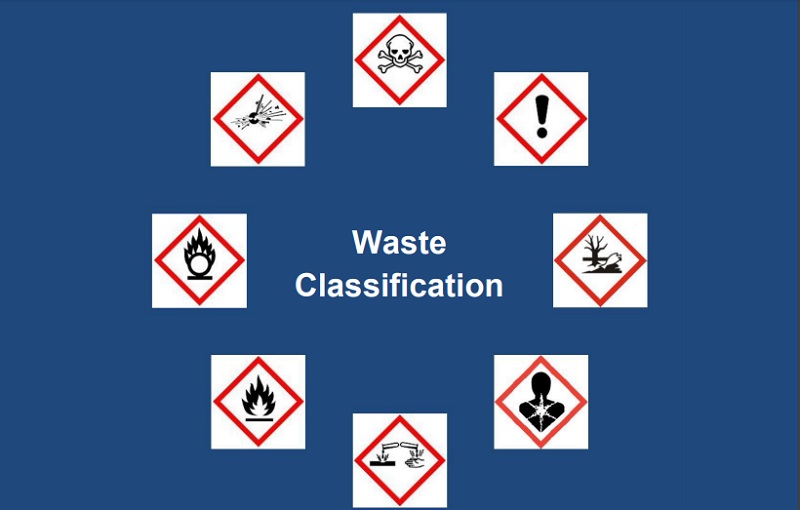Hazardous waste

|
[edit] Introduction
According to the United Nations, more than 400 million tons of hazardous waste is produced globally every year. A by-product of industrial, manufacturing and other processes, hazardous waste can constitute a threat to public health and the environment and, as it cannot be used for any other purpose, must be safely disposed of. Whether in the form of a gas, liquid or solid, its very nature means it can require special handling and processes to render it safe.
If not safely disposed of, hazardous waste can constitute a problem for:
- People – for both present and future generations.
- Animals
- Natural habitats – seas, rivers, estuaries, marshland, forests etc
- Resources – water, agriculture, air
[edit] Potential dangers from hazardous waste
Posing potentially significant dangers, hazardous waste material can display one or more of the following characteristics:
- Ignitable – liquids with a 60°C+ flashpoint such as alcohol, gasoline and acetone; solids which combust spontaneously, and oxidisers and compressed gases.
- Corrosive – acids eg, hydrochloric, sulphuric, nitric, eg battery acids and rust removers.
- Reactive – unstable materials; react violently with water; can change violently without detonating; can produce toxic gases on reaction with water.
- Toxic – poisonous, threaten human and animal health and the environment through single or short-term exposure. This includes some fertilisers, pesticides, raw sewage, heavy metals, CO, asbestos, lead, ground-level ozone and radon (a natural by-product of radioactive decay in rocks).
[edit] Businesses associated with hazardous waste fall broadly into three groups:
- Producers or holders – ie, they produce or store waste.
- Carriers – collect and transport waste.
- Consignees – receive waste eg, for recycling or disposal.
[edit] Different types of hazardous waste produced by the construction industry
The UK government requires businesses to exercise a duty of care to ensure any hazardous waste produced by their operations (business or commercial waste) does not cause harm or damage. Business waste can include any waste that is generated by construction, demolition, industry and agriculture.
The construction sector uses a wide variety of materials for building and repair. Waste generation, some of which is classed as hazardous, can therefore be a problem although recent years have seen significant strides taken to address proper disposal and reduce the amount of waste that goes to landfill. Typically, concrete, bricks, tiles and ceramic waste, as well as wood, plastic and glass must be assessed on site as to whether they constitute a hazard. Products such as coal tar and tarred products are almost invariably hazardous and must be dealt with appropriately.
For more information see: Hazardous materials.
The government classifies hazardous waste under four codes:
- Mirror hazardous (MH) and mirror non-hazardous (MNH): these may be hazardous or non-hazardous.
- Absolute hazardous (AH): these are always hazardous.
- Absolute non-hazardous (ANH): these are always non-hazardous.
[edit] Dealing with hazardous waste
Once a waste material has been identified as hazardous, it is important to have a well-considered waste management plan in place. The plan should offer comprehensive guidelines on how to handle waste, from the point the waste is created, through transportation, treatment, and storage, right up to disposal.
Within an organisation, the waste management plan is used to inform and provide guidance to employees about best practices and laws that regulate the disposal of dangerous waste. The plan also defines roles and responsibilities and provides the framework for action in case of emergency, so that any risks of contamination can be contained.
For more information see: Site waste management plan.
[edit] Related articles on Designing Buildings Wiki
- BREEAM Construction waste management.
- Business HAZMAT plans.
- Construction waste.
- COSHH.
- Definition of waste: Code of practice.
- Disposal.
- Hazardous substances.
- Planning (Hazardous Substances) Act 1990.
- Site waste management plan.
- Waste management - explained.
- Waste management process.
[edit] External references
About the wiki
Anyone is welcome to use and contribute to the wiki in different ways.
[edit] Engaging with the wiki
You can:
- Contribute to existing articles
- Create articles
- Share articles through social media and other channels
- Contact the CIRCuIT project to let us know what you think and how we can improve
[edit] Add your own content
To contribute to or create an article, you can follow these steps:
- Register as a user
- Read through the editorial policy and guidance on writing and contributing to articles
- See the detailed help page on tips on writing wiki articles
- Try editing a test article
- If editing an article, select 'Edit this article' underneath the article title
- If creating a new article, select 'Create an article'. In the 'Select categories' area, expand the 'Industry context' list and tag 'Circular economy' to add your article to this wiki
[edit] Who is this wiki for?
The articles contain information on implementing circular economy approaches in construction that could be relevant to:
- Architects
- Construction contractors
- Designers
- Developers, owners, investors
- Engineers
- Landowners
- Manufacturers and supplier
- Universities and research
- Urban planners
[edit] About CIRCuIT
The Circular Economy wiki is supported by the Circular Construction in Regenerative Cities (CIRCuIT) project, which is funded by the European Union's Horizon 2020 research and innovation programme. CIRCuIT is a collaborative project involving 31 ambitious partners across the entire built environment chain in Copenhagen, Hamburg, Helsinki Region and Greater London. Through a series of demonstrations, case studies, events and dissemination activities, the project will showcase how circular construction practices can be scaled and replicated across Europe to enable sustainable building in cities and the transition to a circular economy on a wider scale.





